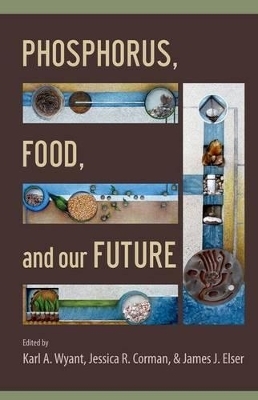
Phosphorus, Food, and Our Future
Oxford University Press Inc (Verlag)
978-0-19-991683-2 (ISBN)
Phosphorus is essential to all life. A critical component of fertilizers, Phosphorus currently has no known substitute in agriculture. Without it, crops cannot grow. With too much of it, waterways are polluted. Across the globe, social, political, and economic pressures are influencing the biogeochemical cycle of phosphorus. A better understanding of this non-renewable resource and its impacts on the environment is critical to conserving our global supply and increasing agricultural productivity.
Most of the phosphorus-focused discussion within the academic community is highly fragmented. Phosphorus, Food, and Our Future will bring together the necessary multi-disciplinary perspectives to build a cohesive knowledge base of phosphorus sustainability. The book is a direct continuation of processes associated with the first international conference on sustainable phosphorus held in the United States, the Frontiers in Life Sciences: Sustainable Phosphorus Summit, though it is not a book of conference proceedings; rather, the book is part of an integrated, coordinated process that builds on the momentum of the Summit. The first chapter will introduce the biological and chemical necessity of phosphorus. The subsequent ten chapters will explore different facets of phosphorus sustainability and the role of policy on future global phosphorus supplies. The final chapter will synthesize all of the emerging views contained in the book, drawing out the leading dilemmas and opportunities for phosphorus sustainability.
James Elser is Professor in the School of Life Sciences at Arizona State University. Karl Wyant and Jessica Corman are graduate students who organized the Frontiers in Life Sciences: Sustainable Phosphorus Summit at Arizona State University.
Table of Contents ; Preface ; Jessica R. Corman, Karl A. Wyant, Lisa Taylor, David Iwaniec, Rebecca Hale ; Chapter 1: Introduction to P sustainability ; P is for Philosophy and Process ; Genevieve S. Metson, Karl A. Wyant, Daniel L. Childers ; Chapter 2: The Biology and Ecology of Phosphorus in Biota, ; Natural Ecosystems, & Agroecosystems ; P is for Phosphorus ; James J. Elser, William A. Roberts, Philip M. Haygarth ; Chapter 3: Global Phosphorus: Geological Sources and ; Demand-Driven Production ; P is for Price ; Donald Burt, Marion Dumas, Nathaniel Springer, David A. Vaccari ; Chapter 4: Sustainable P in agriculture: Food and fuel ; P is for Productivity ; Val H. Smith, Cecil W. Forsberg, Roberto A. Gaxiola, Thomas W. Crawford, Jr., Andrew R. Sharpley, Laura Schreeg, Ben Chaffin ; Chapter 5: Phosphorus in urban and agricultural landscapes ; P is for Preservation ; Shelby H. Riskn, Gaston Small, Robert Mikkelsen Genevieve Metson, Anna Bateman, James Cooper, Ola Stedje Hanserud, Philip M. Haygarth, Cecilia Laspoumaderes, Michelle McCrackin, Sonya Remington ; Chapter 6: Phosphorus Recovery and Reuse ; P is for Processing ; Hiroko Yoshida, Kimo van Dijk, Aleksandra Drizo, Steven W. Van Ginkel, Kazuyo Matsubae, Mark Buehrer ; Chapter 7: Cultural beliefs, values, and the biogeochemical cycling of P ; P is for People ; Timothy Crews, James Cotner, Carol McCreary ; Chapter 8: How MFA, transdisciplinarity, complex adaptive systems thinking, and education reform are keys to better managing P ; P is for Parity ; Rebecca Cors, Kazuyo Matsubae, Anita Street ; Chapter 9: Future Scenarios for the Sustainable Use of ; Global Phosphorus Resources ; P is for Preferred (p)Futures ; Daniel L. Childers, Zachary Caple, Cynthia Carlielle-Marquet, Dana Cordell, Vanda Gerhart, David Iwaniec, Stuart White ; Chapter 10: Concluding Remarks: Synthesis and Initial Steps towards a Sustainable Phosphorus Future ; P is for Planning ; Jessica R. Corman, Karl A. Wyant, James J. Elsner
| Erscheint lt. Verlag | 8.8.2013 |
|---|---|
| Zusatzinfo | 55 bw halftones, 10 additional images at beginning of chapters |
| Verlagsort | New York |
| Sprache | englisch |
| Maße | 236 x 160 mm |
| Gewicht | 510 g |
| Themenwelt | Naturwissenschaften ► Biologie ► Ökologie / Naturschutz |
| Naturwissenschaften ► Chemie ► Anorganische Chemie | |
| Weitere Fachgebiete ► Land- / Forstwirtschaft / Fischerei | |
| ISBN-10 | 0-19-991683-7 / 0199916837 |
| ISBN-13 | 978-0-19-991683-2 / 9780199916832 |
| Zustand | Neuware |
| Haben Sie eine Frage zum Produkt? |
aus dem Bereich


